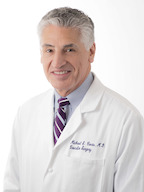Open Aortic Aneurysm Repair
Open abdominal aortic aneurysm repair is surgery to fix a widened part in the aorta, called an aneurysm. The aorta is the large artery that carries blood to your abdomen (belly), pelvis, and legs. An aortic aneurysm is when part of this artery becomes too large or balloons outward.
Abdominal Aneurysm Repair
Open surgical repair of an abdominal aortic aneurysm involves an incision of the abdomen to directly visualize the aortic aneurysm. The procedure is performed in an operating room under general anesthesia. The surgeon will make an incision in the abdomen either lengthwise from below the breastbone to just below the navel or across the abdomen and down the center. Once the abdomen is opened, the aneurysm will be repaired by the use of a long cylinder-like tube called a graft. Grafts are made of various materials. The graft is sutured to the aorta connecting one end of the aorta at the site of the aneurysm to the other end of the aorta. Open repair remains the standard procedure for an abdominal aortic aneurysm repair.
Thoracic Aneurysm Repair
A thoracic aortic aneurysm is an abnormal bulge in a weakened wall of the aorta in the chest area. Thoracic aneurysms occur above the diaphragm, including in the ascending aorta, the aorta arch and the descending thoracic aorta. The current standard surgical treatment of a thoracic aortic aneurysm is the open-chest approach. The main purpose of open-chest surgery to treat a thoracic aneurysm is to replace the weakened portion of the aorta with a graft. Repairing a thoracic aneurysm is surgically complicated and requires an experienced thoracic surgical team.
Thoraco-Abdominal Aneurysm Repair
Thoraco-abdominal aortic aneurysms (TAA) involve the aorta in the chest and abdomen. As such, major branch arteries to the head, arms, spinal cord, intestines and kidneys may originate from the aneurysm. TAAs are serious health risks because, depending on their location and size, the aneurysms may rupture or dissect, causing life-threatening internal bleeding. TAAs are the most complex type of aneurysms and treatment carries a risk of postoperative paralysis. When performing open thoraco-abdominal surgery, it is required to make an incision in both the chest and abdomen, and insert a graft into the damaged aorta. The surgeon will then splice the tube and sew it to the healthy aorta. Blood flow now goes through the graft instead of the aneurysm.
Risks
Complications after aneurysm surgery may include:
- Heart attack
- Irregular heartbeats
- Bleeding
- Stroke
- Paralysis due to injury of the spinal cord
- Graft infection
- Kidney damage
Recovery
Your length of hospital stay following thoracic aneurysm surgery depends on your condition and the operation performed, but it is typically 7 days.
Most people need at least 4 to 6 weeks to recover from thoracic aneurysm surgery. If your aneurysm is extensive, involves intervention to repair other complications, or if you have other conditions such as heart, lung or kidney disease, recovery may take 2 to 3 months. After you’ve had surgery to repair an aneurysm, it is recommended you adopt the same heart-healthy lifestyle led by other heart surgery patients. Your health care team can provide more information.













